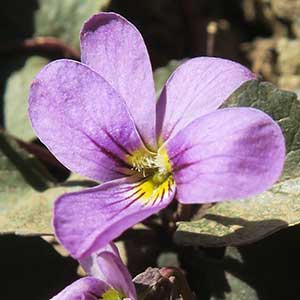Viola flettii
Viola prionantha
Flett's violet, Olympic violet, rock violet
Japanese violet
1–3, ascending to erect, mostly glabrous, on caudex from fleshy rhizome.
basal and cauline;
basal: 1–3;
stipules linear-lanceolate, margins entire or with glandular processes, apex acuminate;
petiole 1.5–9.7 cm, mostly glabrous;
blade purple-tinted and –veined, broadly reniform to ovate, 0.9–2.4 × 1.2–4 cm, base cordate, margins finely crenate-serrate, eciliate, apex acute to obtuse, surfaces glabrous or sparsely pubescent along veins adaxially;
cauline similar to basal except: stipules ovate to lanceolate, margins entire or shallowly laciniate;
petiole 0.7–5.9 cm, usually glabrous;
blade 0.8–2.1 × 1.2–3.1 cm.
basal, 6–22, ascending to erect;
stipules linear-lanceolate, margins remotely denticulate, apex acuminate;
petiole 1–13 cm, narrowly winged distally, glabrous or puberulent;
blade unlobed, oblong-ovate, ovate-lanceolate, or narrowly ovate, 1–4.5(–10) × 0.6–2(–4) cm, base usually truncate, sometimes ± cordate or broadly cuneate, margins crenulate, ciliate or eciliate, apex obtuse or ± acute, surfaces glabrous or puberulent.
1.8–7.1 cm, usually glabrous.
2.5–6 cm, glabrous, bracteoles near middle.
sepals lanceolate, margins eciliate, auricles 0.5–1.5 mm;
petals soft reddish violet on both surfaces, all with yellow area basally, lower 3 dark violet-veined, lateral 2 bearded, lowest with white around yellow area, 10–15 mm, spur yellow, gibbous, 0.5–2 mm;
style head bearded; cleistogamous flowers axillary.
sepals lanceolate or ovate-lanceolate, margins ciliate or eciliate, auricles 1–2 mm;
petals light violet or purple on both surfaces, rarely all white, lower 3 dark violet-veined, lateral 2 beardless or sparsely bearded, lowest 14–25 mm, spur pale to dark violet, elongated, 6–9 mm, tip hooked up;
style head beardless; cleistogamous flowers present.
± spherical, 5–9 mm, glabrous.
narrowly ellipsoid, 5–12 mm, glabrous.
dark brown to brownish purple, 2.5–3 mm.
dark brown, ca. 2 mm.
= 48.
Viola flettii
Viola prionantha
Viola flettii is endemic to the Olympic Mountains of northwestern Washington. C. S. McCreary (2005) noted that although morphologically and ecologically distinct, V. cuneata, V. flettii, and V. ocellata are closely related.
(Discussion copyrighted by Flora of North America; reprinted with permission.)
In 1952, plants of Viola initially identified as V. patrinii were collected and reported by C. T. Rogerson to be established in lawns on the campus of Kansas State University, Manhattan, Kansas, where they are still found. S. B. Rolfsmeier recently determined that these plants are V. prionantha. R. B. Kaul reported that V. prionantha occurs along roadsides in Kansas and is also established in the floodplain of the North Platte River in Nebraska, where it was first collected by him in 1992.
(Discussion copyrighted by Flora of North America; reprinted with permission.)


